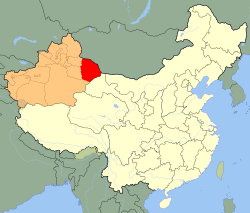
Back Kumul xanlığı Azerbaijani Khanat Kumul German Kanato de Kumul Spanish Khanat Kumul French Kekhanan Kumul ID Khanato Kumul Italian ハミ郡王家 Japanese 쿠물 칸국 Korean Кумул Хандыгы Kirghiz Кумульское ханство Russian
Kumul Khanate قۇمۇل خانلىقى 哈密札薩克旗 | |||||||||
|---|---|---|---|---|---|---|---|---|---|
| 1696–1930 | |||||||||
 Location of the Kumul Khanate | |||||||||
| Status | Banner of the Qing dynasty (1696–1912)[1] Vassal of the Republic of China (1912–1930) | ||||||||
| Capital | Kumul, Xinjiang | ||||||||
| Common languages | Chinese language, Chagatai language (predecessor of Turki Uyghur)[2] | ||||||||
| Religion | Sunni Islam | ||||||||
| Demonym(s) | Kumulik | ||||||||
| Government | Monarchy | ||||||||
| Khan | |||||||||
• 1867–1882 | Muhammad Shah | ||||||||
• 1882–1930 | Maqsud Shah (last) | ||||||||
| Chancellor/Baig[3] | |||||||||
• 1922–1930 | Yulbars Khan (last) | ||||||||
| History | |||||||||
• Established | 1696 | ||||||||
| 1930 | |||||||||
| Currency | Xinjiang coins | ||||||||
| |||||||||
| Today part of | China | ||||||||
The Kumul Khanate was a semi-autonomous feudal Turco-Mongol khanate (equivalent to a banner in Mongolia[4]) within the Qing dynasty and then the Republic of China until it was abolished by Xinjiang governor Jin Shuren in 1930. The khanate was located in present-day Hami prefecture of Xinjiang.
- ^ 王希隆; 杨代成, eds. (2018). "清顺康雍三朝对天山以南地方政权与地方势力政策述评1 ———以叶尔羌、哈密、吐鲁番与清朝的互动关系为中心" [A Review of the Policies of Emperor Shunzhi,Kangxi and Yongzheng of the Qing Dynasty towards the Local Authorities and Powers in the South of Tianshan Mountains] (PDF). CASS.
接受招抚的哈密、吐鲁番土著首领额贝都拉、额敏和卓先后各率近万名部属投归清朝,被编设为两个札萨克旗
- ^ "Chagatai literature". Encyclopedia Britannica. Retrieved 2021-09-19.
- ^ "Political System". History Research Society of Qing Dynasty in Singapore. 14 October 2012.
- ^ 达远, 黄. "试论清代哈密回旗". 新疆大学中亚文化研究所.
© MMXXIII Rich X Search. We shall prevail. All rights reserved. Rich X Search